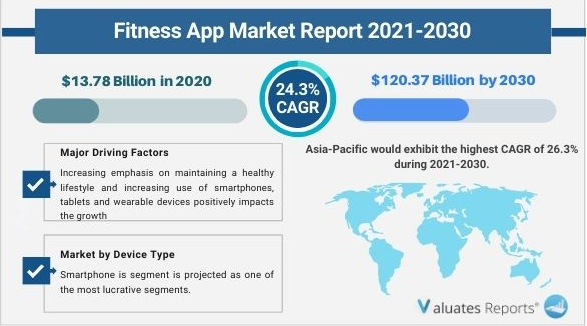Fitness App Development: 7 Things to Consider Before Building the App

Many of us strive to lead a healthy life but find it difficult to materialize. Often, we get motivated to be healthier, start working out more, buy quality food, and then all of a sudden, lose motivation and fall off the wagon.
Turning to health and fitness app development can help a great deal, from providing motivation to live up to the fitness regime to connecting us with a larger fitness activity and engagement community.
Seeing the potential of fitness apps, their surging demand, and the growing fitness app development market, many business owners are seeking the support of fitness app development companies to build an app for them.
Notably, the fitness app market witnessed a valuation of USD 13.78 billion in 2020 and is anticipated to reach USD 120.37 billion by 2030, with a projected CAGR of 24.3% from 2021 to 2030. The fitness app market is dominated by top fitness apps such as Fitbit, MyFitnessPal, Azumio, Appstore, and more.
If you are one of those business owners planning to build a health & fitness app, there are several things that you need to consider before actually getting into the development. In fact, hiring a mobile application development company would be the last thing you would be doing.
To assist you, here, we have identified 7 things you should consider while engaging in health & fitness app development. Using this list as a checklist will help you build the best fitness app.

Image Source: reports.valuates.com
1. Know the top trends
Fitness apps have completely transformed the way we approach our health and wellness goals. With advancements in technology, these apps have evolved to provide a personalized and seamless experience. Let’s dive into the top trends shaping the fitness app industry, and discover how these innovations are revolutionizing the way we stay fit and healthy.
- Wearable Devices: One exciting trend in fitness app development is the integration with wearable devices. Fitness apps now seamlessly connect with popular fitness trackers and smartwatches. This connection allows users to track their workouts, monitor vital signs, and get real-time data for better fitness tracking.
- Gamification: To keep users motivated and engaged on their fitness journey, gamification has become a popular trend. Fitness apps now incorporate game-like elements such as challenges, rewards, and leaderboards.
- Personalization: Another trend taking the fitness app world by storm is personalization and artificial intelligence (AI). These apps now use advanced algorithms and AI technology to provide personalized workout plans, nutrition recommendations, and coaching sessions tailored to individual goals and preferences.
- Social Features: The power of social interaction and community engagement has become a significant trend in fitness app development. Fitness apps now offer social features that allow users to connect with friends, join communities, and share their achievements on social media.
- Virtual Classes and Remote Training: With the rise of virtual fitness, apps now offer virtual classes and remote training sessions. Users can access a wide range of workout classes, from yoga to dance, anytime and anywhere.
- Health Monitoring and Biometric Tracking: Fitness apps now offer more sophisticated health monitoring and biometric tracking capabilities. Users can monitor their heart rate, sleep patterns, calorie intake, and stress levels through their fitness apps.
- Virtual Reality and Augmented Reality: Exciting emerging technologies like VR and AR are making their way into fitness app development. These immersive technologies provide users with unique and engaging workout experiences.
2. Must-Have Features in Fitness Apps
When it comes to creating fitness apps, there are certain features that you’ll find in most of them. Let’s explore those features and also dive into some cool and innovative additions that can make your fitness app stand out:
- User Registration and Profile: Every fitness app asks you to create an account and set up a profile. This helps the app understand your goals and personalize your fitness journey.
- Activity Tracking: Most fitness apps let you track different activities like walking, running, or cycling. They use your phone’s sensors to measure distance, speed, and calories burned.
- Workout Plans: You’ll usually find pre-designed workout plans and a library of exercises in fitness apps. These plans cater to different fitness levels and goals, giving you guidance on what to do during your workouts.
- Progress Tracking: Fitness apps allow you to track your progress over time. You can see how much weight you’ve lost, how many steps you’ve taken, or how long your workouts have been. They also provide helpful visuals and analytics to help you understand your progress.
- Nutrition and Diet Tracking: Many fitness apps offer features to track your food intake and monitor your nutrition. You can log your meals, set calorie goals, and get suggestions for healthier eating habits.
- Social Sharing: Some fitness apps let you connect with friends and other users, share your achievements, and even participate in challenges together. It’s a great way to stay motivated and get support from others.
- Push Notifications: Fitness apps like to keep you engaged and on track with your goals, so they send you reminders and motivational messages. These can be workout reminders, inspirational quotes, or tips for healthy living.
- Third-Party App Integration: Instead of navigating between different apps or platforms, users can access all their health-related information in one place. Whether it’s syncing data from wearable devices or fitness apps, third-party app integration simplifies data aggregation and provides a holistic view of their health.
Now, let’s talk about some unique and exciting features that create fitness apps even better:
- Personalized Coaching: Imagine having a virtual trainer guiding you through your workouts or providing personalized coaching based on your needs and progress. It’s like having your own fitness expert right in your pocket.
- Augmented Reality (AR) Workouts: How about adding a touch of magic to your app? With AR technology, users can follow virtual trainers, see exercise demos in their real environment, and even join interactive fitness games.
- AI-based Recommendations: Using the power of artificial intelligence, your app can provide customized workout and nutrition recommendations based on each user’s goals, preferences, and progress. It’s like having a personal fitness assistant by your side.
- Live Streaming: Offering virtual fitness classes or live streaming sessions within your app gives users the opportunity to participate in real-time workouts led by expert trainers, all from the comfort of their own homes.
- Integration with Health Data: By integrating your app with health data from external sources like electronic health records or healthcare providers, you can provide a more comprehensive view of a user’s overall health. This can facilitate better collaboration between fitness and healthcare professionals.
3. Monetization Strategy
Creating a mobile app monetization strategy right at the beginning will help you plan out how to realize the maximum benefit of your fitness app. Although app monetization requires extensive marketing support before and after the launch, fitness workout app owners are recommended to create an effective app monetization strategy right at the beginning.
Here are the most common model followed in the mobile app industry:
- Paid Model: This straightforward approach involves users paying upfront to download and access your app. It works best for apps with strong brand recognition and exceptional reviews, enticing users to invest in a premium experience.
- In-app Purchases: This model allows users to download the app for free while offering additional virtual products or features for purchase within the app. It provides a flexible revenue stream by catering to users’ specific needs and preferences.
- Freemium: The freemium model grants users access to basic app features for free while offering advanced functionalities for a fee. This approach entices users to experience the app’s value before deciding to invest in a more comprehensive experience.
- Paywalls: Subscription-based models, like paywalls, offer users time-limited access to the app’s premium content or features upon payment. Netflix serves as a prime example of this model, providing exclusive content for subscribers.
- In-app Advertising: This popular monetization model incorporates advertisements within the app experience. Ads can be displayed at specific intervals or in static forms like stickers, promoting other products or services and generating revenue through sponsorships.
To identify which model suits you the best, you have to focus on the purpose of the app and the type of users you are planning to serve. You can also check out which monetization model your competitors are following and also the latest trends in app monetization.
4. Planning a Fitness App Budget
Creating a budget for Fitness App Development is a tough task. The Internet is flooded with questions like how much it cost to develop a fitness app to develop an iOS fitness app or how much it would cost to develop a fitness application to make an Android fitness app.
When planning a fitness app budget here are a few things that you need to consider:
- Identify the need for creating the app
- Analyze the platform cost – The cost of building an app for personal trainers, fitness enthusiasts, or device manufacturers for a specific platform
- Decide whether you are going to build in-house or outsource to a fitness app development company
- Precisely evaluate the functionality and features
- Submitting the app to the app-stores
- Allocating the marketing budget
Once you examine all the fitness app development cost factors, you can allocate a budget to each of these and finally fix an overall budget for fitness app development. You may explore a few lesser-known ways to reduce the cost of application development and prevent budget overruns.
5. Development Process
Building a fitness app that truly resonates with users requires a well-defined development process. By following a systematic approach, you can ensure that your app not only meets industry standards but also fulfills the unique needs of your target audience. Let’s dive into the key steps involved in the development process:
- Ideation: This initial phase involves brainstorming and identifying the core concept of your fitness app. Define your app’s purpose, target audience, and the problem it aims to solve. Conduct market research to understand user preferences, identify gaps in the market, and explore potential competitors.
- Market Research: Thorough market research is crucial to gather insights about user expectations, popular trends, and successful features in the fitness app industry. Identify the unique selling points that will set your app apart from others and resonate with your target audience.
- Design: In this phase, focus on creating an intuitive and visually appealing user interface (UI) and user experience (UX). Design the app’s architecture, wireframes, and prototypes. Consider factors like ease of navigation, color schemes, and typography to enhance user engagement.
- Development: This stage involves the actual coding and development of the app. Select the appropriate technology stack and frameworks based on your app’s requirements. Develop the front-end and back-end components, integrating features like user profiles, fitness tracking, goal setting, and social sharing.
- Testing: Thoroughly test your app to ensure its functionality, performance, and compatibility across various devices and operating systems. Conduct both manual and automated testing to identify and fix any bugs or glitches. Seek feedback from beta testers to gather valuable insights for further improvements.
- Deployment: Prepare your app for release on the chosen app stores. Follow the guidelines and requirements of platforms like the Apple App Store and Google Play Store. Optimize your app’s metadata, such as app title, description, and keywords, to improve its visibility and discoverability.
7. Hybrid or Native Fitness App
Building a fitness app requires careful consideration of various factors, including the choice between a hybrid or native app development approach. Both options have their pros and cons, and it’s essential to assess your specific needs and priorities before making a decision. Let’s explore the key factors to consider:
- Performance: Native apps offer superior performance as they are developed specifically for a particular platform, leveraging the device’s full potential. Hybrid apps, on the other hand, use web technologies wrapped in a native container, which can impact performance to some extent.
- User Experience: Native apps provide a seamless and intuitive user experience by leveraging platform-specific design patterns and features. Hybrid apps can achieve a similar experience, but they may lack the same level of polish and responsiveness.
- Development Time and Cost: Hybrid apps can be developed faster and at a lower cost compared to native apps, as they can be built using web technologies that are shared across multiple platforms. Native apps require separate development for each platform, which can increase development time and cost.
- Access to Device Features: Native apps have direct access to a device’s hardware and software features, such as GPS, camera, and sensors. This allows for deeper integration and utilization of these features, enhancing the app’s functionality. Hybrid apps rely on plugins or third-party libraries for accessing device features, which may not provide the same level of control.
- Platform Support: Native apps have broader platform support, as they are specifically developed for iOS or Android. Hybrid apps can be deployed on multiple platforms, including iOS, Android, and web, which can be advantageous if cross-platform compatibility is a priority.
- Maintenance and Updates: Native apps require separate maintenance and updates for each platform, which can be more time-consuming. Hybrid apps, on the other hand, allow for easier maintenance and updates as changes can be made once and applied across multiple platforms.
- Development Expertise: Consider the expertise of your development team. Native app development requires platform-specific knowledge, whereas hybrid app development relies on web technologies. Assess the skill set of your team and determine which approach aligns better with their capabilities.
Hire a Fitness App Development Company
Outsourcing the fitness app development task to a custom mobile app development agency will help you reduce the burden of technical complexity and allow you to focus on the core tasks like revenue generation and increasing user retention & user engagement.
Many companies often commit grave mistakes while a technology team for their product development, which could be devastating for the business. When a hiring tech team, you should ensure certain factors such as:
- Check Portfolio: Always check the portfolio of the fitness or workout app development company to ensure that they have relevant experience in the domain.
- Platform: By checking the platform they mostly develop for, you gain a general idea of their efficiency and what kind of team they must be having.
- Engagement Model: Find out what app development methodology they follow. Common methodologies are Agile software development, crystal methods, feature-driven development, and lean development.
- Timeline: Discuss the fitness and workout app development timeline with your fitness mobile app agency and based on that set the milestones for payment.
Final Thoughts
Well, launching health and fitness apps need better planning for the business and precise execution of the app development operations. A reliable healthcare app development company can help you assess possible risks and avoid pitfalls as a team. So when planning to build an app, make sure you take into account crucial factors for successful app development.
At Finoit Technologies, we specialize in developing cutting-edge fitness apps that cater to the unique needs of businesses and users. With our expertise in mobile app development and a deep understanding of the health and fitness industry, we can guide you through the entire app development process, from ideation to launch. Trust us to deliver a robust, engaging, and user-friendly fitness app that drives your business growth. Contact us today to get started on your fitness app journey.

